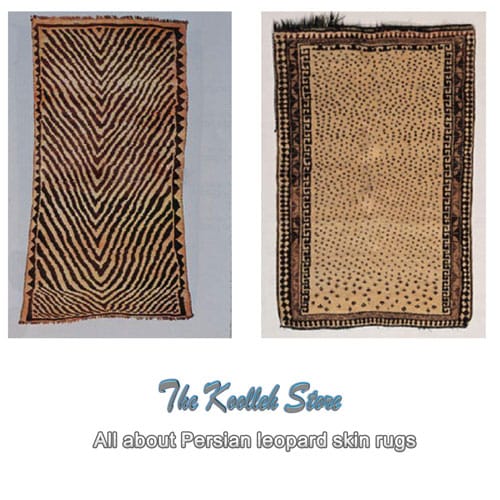All about Persian leopard skin rugs

One of the most important designs of Iranian carpets is carpets, which are known as leopard skin or tiger skin carpets. Although most of these carpets are used by dervishes, they should not be considered as specific to dervishes, because as we will see, other groups of people, including nomads and tent dwellers, are also very interested in this map and these carpets. At that time, the skins of role-playing animals (such as leopards and tigers) were superior to those of roleless animals (such as lions and deer). Perhaps when mankind learned to weave, one of the maps he became interested in was the leopard and tiger skin map. There is no evidence that can be substantiated, but there is one thing that can be relied upon, and that is the special passion that dervishes and tent dwellers have for nature, animals and soil.
Much of the people’s small property has been given to them by nature. The dervishes’ cache, which is a container of water and food, is nothing but a sea coconut. The woodwork and their defenses are barbed wood. Metal chisels or steel axes are more advanced and newer tools that are inspired by rubber and plant extracts. As for the bodyguard, the undergarment and the cover, the dervishes were at least satisfied and used a piece of animal skin or, if they did not have access to it, a piece of cloth to cover themselves and as their underlayment when sitting and sleeping. . However, in spite of all this poverty and contentment, the dervishes do not consider themselves inferior to the sultans. They call it the “royal throne” and often associate its name with the title of king. Shah Nematullah or Noor Ali Shah and Mushtaq Alisha are examples of these titles. The connection of leopard and tiger skin with kings and heroes in Iranian mythology is a long one. In describing Rostam, Ferdowsi mentions his “expression tiger”. The connection of leopard and tiger skin with kings and heroes in Iranian mythology is a long one. In describing Rostam, Ferdowsi mentions his “expression tiger”. In the paintings that have survived from the eighth century AH onwards, some kings and warriors wear these two animals. One of the oldest of these paintings, which dates back to the early eighth century AH and is now in the Free Gallery in Washington, D.C., Kiomars shows the first mythical king of Iran by wearing leopard skin and tiger skin undergarments. Another notable scene from Kiomers is a painting attributed to Sultan Muhammad. This painting, which is undoubtedly one of the masterpieces of early painting, depicts Kiomers and other courtiers with leopard skin coats and one of them with tiger skin coats. There are many commonalities between kings and dervishes. The main reason for this is the common appearances and tools of the two peoples. Both groups have become needless, one in wealth and the other in poverty, and both groups rule their property. The kings who rule the land are limited to borders and gates, but the king of the dervishes is not a gatekeeper. As for the leopard and the tiger, as well as the lion, the kings gained their power in the scenes of the war with these animals, which in turn were the king of the forest and the forest, by defeating them and illustrating these scenes on the rock, mountain and book. They show off to others and say to the people in a tongue-in-cheek manner, “The king who rules over you is superior to all powers.” The dervishes, who consider the land as their property, also show their dependence on the land and their dominance over its factors by wearing or sitting on the skins of animals or sitting on them. The lifestyle of the nomads and nomads is not far from their harvests and kings. The entrance to the plains, mountains and valleys is open to nomads. Wherever they decide, they build their tents and rule the area for a while. And they know their environment. The connection of this people with the earth and nature and animals is the same close relationship that the dervishes have. In addition, these people own sheep and weaving tools and are proficient in technology. So if nomadic women weave the leopard and tiger skin on their carpets, they won’t do anything strange.
Leopard and tiger skin rugs (as well as milk) are also a symbol of courage and bravery for nomads. By weaving these carpets and throwing them on the floor of the tent, the nomadic woman recounts the legends of hunting these powerful and dangerous animals to her children in the hands of her ancestors and encourages her husband and sons to follow the past in boldness and fearlessness. Slow down.
Leopard skin and tiger skin that nomadic women weave is not an imitation of tiger and leopard skin. These women, who are very good at weaving all kinds of designs and have creative and unlimited ideas, go far beyond the leopard and tiger design and turn these designs into different shapes. Sometimes the whole surface of a carpet is covered with leopard and tiger skin maps, and sometimes by adding a few colors, these maps are changed from two-tone to multi-colored, and sometimes they go so far as to introduce the viewer to the roots of these maps. No, they are confused and remember modern and contemporary works. If we consider leopard skin carpets to be specific to Iran and their roots originated in Iran, we should consider a much wider land for cut leather carpets. One side of the land is China and Machin, and the other is India. Tibet weaves most of the tiger skin rugs. In West Asia, Iran and Turkey have the largest share. Turkey’s share is mostly in textiles and Iran’s share is in both textiles and carpets.






